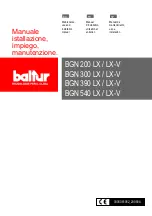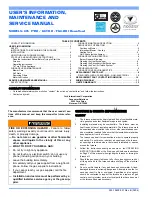
420706-UUM-C-0112
2
Johnson Controls Unitary Products
7.
NEVER . . .Store flammable materials of any kind near your fur-
nace. Gasoline, solvents, and other volatile liquids should be
stored only in approved containers outside your home. These
materials vaporize easily and are extremely dangerous.
8.
NEVER . . .Store cleaning materials near your furnace. Materials
such as bleaches, detergents, powdered cleansers, etc., can
cause corrosion of the heat exchangers.
9.
NEVER . . . Use the area around your furnace as a storage area
for items which could block the normal flow of air. This flow of air is
required for ventilation of the various furnace components.
SECTION II: INSTRUCTIONS FOR
EXAMINING THE FURNACE
INSTALLATION
It is the owner’s responsibility to ensure that an annual inspection of the
entire heating portion of the unit is made by a qualified service agency.
Examine the furnace as outlined below in steps “1 - 8” before each
heating season. Use Figure 1 for visual reference.
1.
Examine the heat exchanger, vent pipe, combustion air passages,
vent connectors and chimney to be sure they are clear and free of
obstructions.
2.
Examine the vent pipe making sure it is firmly in place, that it
slopes slightly upward and is physically sound without holes and
all of the connections are secure.
3.
Examine return connections
• For Modular Homes:
a. If the furnace has a return air duct, examine the return air
duct connections to make sure they are physically sound,
sealed to the furnace casing, and the ducts terminate out-
side the space containing the furnace.
b. If the furnace does not have a return air duct, examine the
return air filter rack connections to make sure they are phys-
ically sound, sealed to the furnace casing.
•
For Manufactured (Mobile) Homes:
a. Examine the return air filter rack connections to make sure
they are physically sound, sealed to the furnace casing.
4.
Examine the furnace casing making sure the physical support is
sound without sagging, cracks or gaps. Examine the furnace base
making sure it is physically sound without cracks, gaps or sagging
and has a good seal.
5.
Examine the furnace casing for obvious signs of deterioration.
6.
Examine the burner flames to make sure they are in good adjust-
ment. Refer to the pictorial sketch shown in Figure 2 as a compari-
son to the actual flame.
7.
Examine and replace external air filters as needed to make sure
they are not blocked, and proper airflow is provided to the furnace.
8.
Examine any installed accessories or system components such as
evaporator coils to insure proper operation, drainage of conden-
sate, and that there is no water leakage or damage to the furnace
or any components.
SECTION III: START-UP AND SHUTDOWN
INSTRUCTIONS
Read the Instructions Below Before Trying to Start the
Furnace!
FIRE OR EXPLOSION HAZARD
This furnace is designed and approved for use with Nat-
ural Gas and (LP) Propane Gas ONLY. DO NOT BURN
ANY LIQUID FUEL OR SOLID FUEL IN THIS FURNACE.
Burning any unapproved fuel will result in damage to the
furnace heat exchanger, which could result in Fire, Per-
sonal Injury, and/or Property Damage.
FIGURE 1:
Component Location - 95% Single Stage Models
Vent Pipe
Pressure
Switch
Manifold
Pipe
Rollout
Safety Switch
Gas Valve
Flame Sensor
Manifold Draft
Assembly
Limit Switch
Ignitor
Safety
Door Switch
Control
Board
Electrical
Junction Box
Blower
Transformer
Capacitor
Condensate
Pan
Silicone Tube
FIGURE 2:
Burner Flame Drawing (Upflow Configuration Shown)
If you do not follow these instructions exactly, a fire or
explosion may result causing property damage, personal
injury, and/or loss of life.
BLUE CONE PORTION OF FLAME SHOULD
ENTER HEAT EXCHANGER TUBE
























